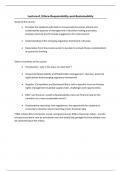Lecture-0_Ethics-Responsibility-and-Sustainability
Goals of the course:
• Provides the students with skills to incorporate the social, ethical and
sustainability aspects of management in decision making processes,
analyses policies and formulate suggestions for improvement
• Understanding of the emerging regulatory framework in Europe
• Expectation from the private sector to be able to include those considerations
in economic thinking.
Table of contents of the course
• Introduction : why is the topic so important ?
• Corporate Responsibility and Stakeholder management : theories, practical
applications and emerging regulatory frameworks
• Supplier, Competitors and Business Ethics: with a specific focus on Human
rights management in global supply chain, challenges and opportunities
• ESG* and Finance: a path to Sustainability, how can Finance help for the
transition to a more sustainable world ?
• Sustainability reporting: new regulations, the opportunity for students in
economy to develop robust reporting of non-financial data.
*ESG-criteria (Environmental, social, and governance): ESG-criteria zijn milieu-, sociale
en bestuurscriteria voor de activiteiten van een bedrijf die gevolgen kunnen hebben voor
de samenleving of het milieu.
, Lecture-1_Sustainability
Time to embed ethics in management?
• Acceleration of the global awareness
• We observe stress on the planet → climate change
• It is time to move from concepts to action
• It is a fairly new field, it evolves fast and has impact in Finance, Marketing,
Governance, Innovation, HR so in General Management.
Terminology:
Corporate Social Responsibility (CSR):
• Most longstanding concept: based upon Carroll’s pyramid model*
• Reflects Anglo-American business model
• Inclusion of broader set of responsibilities e.g. environment
CSR → as a company we have a responsibility to the society where we corporate and our
impact on the environment etc, CSR is a broader concept around this
Example: having employees in different companies around the world, how do we decide
how much we pay who? → important business decision!
*Carroll’s pyramid model:
,Business Ethics:
• Umbrella label for CSR: rooted in philosophy
• Concerned with the morality of business practices
• CSR is oriented towards the wider role of the corporation in the global
economy
Business ethics verwijst naar de principes en normen die van toepassing zijn op het
gedrag en de handelspraktijken in een zakelijke omgeving. Het gaat om het bevorderen
van eerlijkheid, integriteit, transparantie en verantwoordelijkheid in alle aspecten van
zakelijke activiteiten. Kortom, het gaat erom ethisch verantwoorde beslissingen te
nemen en te handelen binnen een bedrijfscontext. Vb: gedragscode in bedrijven
Sustainability:
• Originating from forestry and environmental management
• Refers to broader set of social, economic and environmental
imperatives
• Political interest in sustainable development: reflects ‘Contemporary
CSR’
Big companies started talking about 2 years about the political role of the company, it’s
important and new.
Corporate Citizenship:
• Developed in 1990s to evoke notion of corporation as a ‘good
neighbour’
• Reveals changing nature of role of business in society: political
governance
• Young, but one of the most dynamic debates in CSR literature
→ A company is a moral entity, as a company you should behave a bit like a citizen, you
should be part of your environment, you should act like a “good neighbour”.
, Emergence of a common language :
• The Sustainable Development Goals (SDG’s)* from United Nations
• A common objective for the world: 2030
• A glue across public sector – non profit organizations and the private sector
• A common language for all
*SDG’s: De duurzame ontwikkelingsdoelstellingen zijn in 2015 door de Verenigde Naties
vastgesteld als de nieuwe mondiale duurzame ontwikkelingsagenda voor 2030. Ze
worden gepromoot als de wereldwijde doelstellingen voor duurzame ontwikkeling.
The limits to growth (1972):
In 1972, a book called The Limits to Growth created an international sensation.
Commissioned by the Club of Rome, an international group of businessmen,
statesmen, and scientists, The Limits to Growth was compiled by a team of experts from
the U.S. and several foreign countries. Using system dynamics theory and a computer
model called “World3,” the book presented and analyzed 12 scenarios that showed
different possible patterns—and environmental outcomes—of world development
over two centuries from 1900 to 2100.
The World3 scenarios showed how population growth and natural resource use
interacted to impose limits to industrial growth, a novel and even controversial idea at
the time. In 1972, however, the world’s population and economy were still comfortably
within the planet’s carrying capacity. The team found that there was still room to grow
safely while we could examine longer-term options.
The 2004 update of the study showed that the previous 30 years had shown some
progress, including new technologies, new institutions, and a new awareness of
environmental problems. Nevertheless, the authors were far more pessimistic than they
were in 1972.




